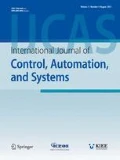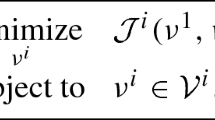Abstract
There is limited formal mathematical analysis of one type of games — dynamic sequential games with large, or even infinitely large, planning horizons, from the point view of system controls. In this paper, we use a zero-sum game theoretical approach to address the disturbance attenuation analysis of state feedback Nash strategies for Dynamic Linear Quadratic Sequential Games (LQSGs) with uncertainties or disturbances. Based on the assumption that the disturbance will do the worst to the normal game players, we provide a simultaneous zero-sum game formulation between nature and each player, and a non-zero sum formulation among the players. For finite-horizon LQSGs, we first provide state feedback Nash strategies with optimal attenuation levels. Then we extend the approach to infinite-horizon LQSGs. We prove that the feedback system is Bounded Input Bounded Output (BIBO) stable with respect to the disturbances.
Similar content being viewed by others
References
W. White, “Representation and approximation of noncooperative sequential games,” SIAM Journal on Control and Optimization, vol. 18, pp. 33–48, 1980.
R. Selten, “Re-examination of the perfectness concept for equilibrium points in extensive games,” International Journal of Game Theory, vol. 4, pp. 25–55, 1975.
G. Zames and B. A. Francis, “Feedback, minimax sensitivity, and optimal robustness,” IEEE Trans. Autom. Control, vol. 28, pp. 585–601, May 1983.
B.-S. Kim and M.-T. Lim, “Robust H∞ control method for bilinear systems,” Int. J. of Control, Automation, and Systems, vol. 1, no. 2, pp. 171–177, 2003.
Y.-J. Kim and M.-T. Lim, “Parallel robust H∞ control method for weakly coupled bilinear systems with parameter uncertainties using successive galerkin approximation,” Int. J. of Control, Automation, and Systems, vol. 4, no. 6, pp. 689–696, 2006.
H. Gao and T. Chen, “H∞ estimation for uncertain systems with limited communication capacity,” IEEE Trans. Autom. Control, vol. 52, no. 11, pp. 2070–2084, 2007.
J. Xu and L. Yu, “H∞ control of 2-D discrete state delay systems,” Int. J. of Control, Automation, and Systems, vol. 4, no. 4, pp. 516–523, 2006.
J. Helton and M. James, “Reduced-complexity nonlinear H∞ control of discrete-time systems,” IEEE Trans. Autom. Control, vol. 50, no. 11, pp. 1808–1811, 2005.
S.-L. Dai and J. Zhao, “Reliable H∞ controller design for a class of uncertain linear systems with actuator failures,” Int. J. of Control, Automation, and Systems, vol. 6, no. 6, pp. 954–959, 2008.
T. Basar and P. Bernhard, H ∞ -Optimal Control and Related Minimax Design Problems: A Dynamic Game Approach. Boston, Birkhäuser, MA, 1991.
D. Shen, Nash Strategies For Dynamic Noncooperative Linear Quadratic Sequential Games, Dissertation, The Ohio State University, 2006.
Author information
Authors and Affiliations
Corresponding author
Additional information
Recommended by Editorial Board member Duk-Sun Shim under the direction of Editor Jae Weon Choi. This research was sponsored in part by the Defense Advanced Research Project Agency (DARPA) under Contract F33615-01-C3151 issued by the AFRL/VAK, and in part by DAGSI through the Ohio State University, Columbus, OH, USA.
Dan Shen received the B.S. degree in Automation from Tsinghua University, Beijing, China, in 1998, the M.S. and Ph.D. degrees in Electrical Engineering from The Ohio State University (OSU), Columbus, in 2003, 2006, respectively. Currently, he is a research scientist at Intelligent Automation, Inc., Rockville, MD. From 1998 to 2000, he was with Softbrain Software Co., Ltd., Beijing, China, as a software engineer. From September 2005 to March 2006, he was an intern at Intelligent Automation, Inc. His research interests include game theory and its applications, optimal control, and adaptive control.
Jose B. Cruz, Jr. received the B.S. degree in Electrical Engineering (summa cum laude) from the University of the Philippines (UP) in 1953, the S.M. degree in Electrical Engineering from the Massachusetts Institute of Technology (MIT), Cambridge in 1956, and the Ph.D. degree in Electrical Engineering from the University of Illinois, Urbana-Champaign, in 1959. He is currently a Distinguished Professor of Engineering and Professor of Electrical and Computer Engineering at The Ohio State University (OSU), Columbus. Previously, he served as Dean of the College of Engineering at OSU from 1992 to 1997, Professor of electrical and computer engineering at the University of California, Irvine (UCI), from 1986 to 1992, and at the University of Illinois from 1965 to 1986. He was a Visiting Professor at MIT and Harvard University, Cambridge, in 1973 and Visiting Associate Professor at the University of California, Berkeley, from 1964 to 1965. He served as Instructor at UP in 1953–1954, and Research Assistant at MIT from 1954 to 1956. He is the author or coauthor of six books, 21 chapters in research books, and numerous articles in research journals and refereed conference proceedings. Dr. Cruz was elected as a member of the National Academy of Engineering (NAE) in 1980. In 2003, he was elected a Corresponding Member of the National Academy of Science and Technology (Philippines).
Rights and permissions
About this article
Cite this article
Shen, D., Cruz, J.B. Disturbance attenuation analysis of state feedback Nash strategy for two-player Linear Quadratic Sequential Games. Int. J. Control Autom. Syst. 7, 905–910 (2009). https://doi.org/10.1007/s12555-009-0605-x
Received:
Revised:
Accepted:
Published:
Issue Date:
DOI: https://doi.org/10.1007/s12555-009-0605-x




